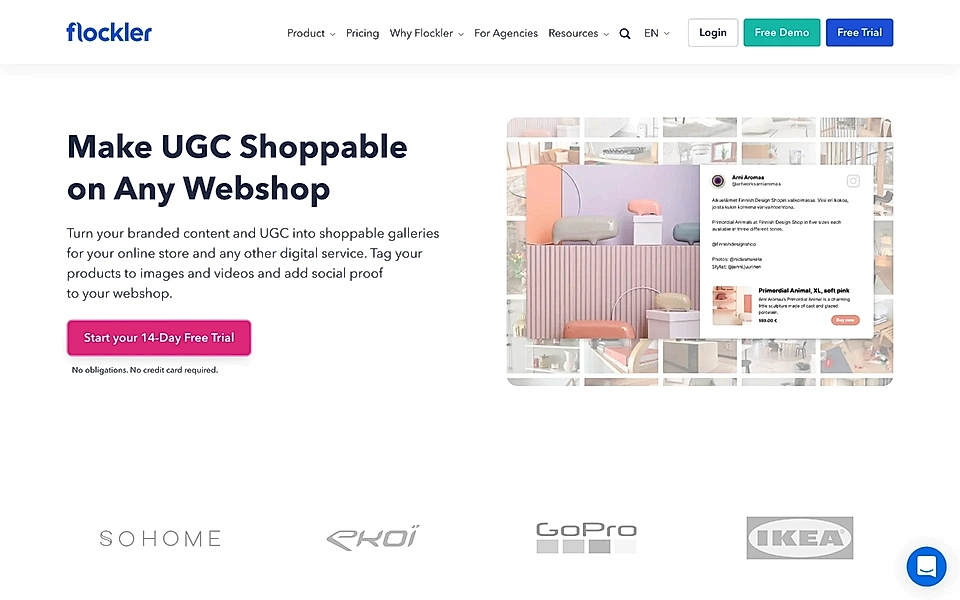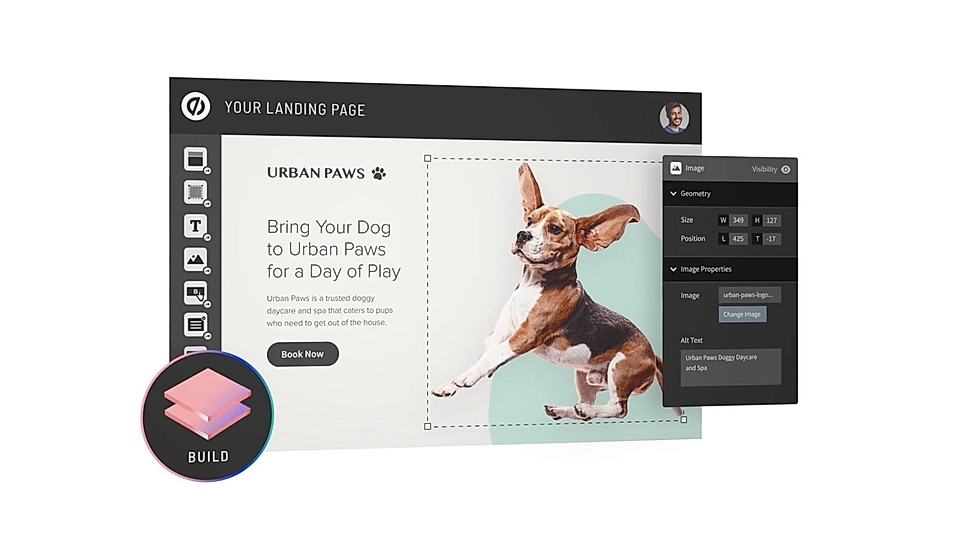Three ways to build SaaS landing pages (and their pros and cons)
When your product-led SaaS grows, you’ll also notice an increase in the number of landing pages.
To maximize the page’s relevance for the website visitor and increase conversion rates, you’ll need multiple SaaS landing page types in your toolkit – solution and feature-specific product pages, PPC, social media ads, competitor comparisons, and many more landing page variations.
What‘s the best way of building SaaS landing pages?
Annoyingly, there’s no one-size-fits-all answer, and many companies might need to use multiple approaches depending on their resources and main website technology at a given time.
In this blog post, I’ll compare the pros and cons of three ways to build SaaS landing pages:
- Custom pages: A marketer working with in-house or external developers and designers to build bespoke pages.
- Ready-made templates: A marketer repurposing templates often provided by one of the modern CMSs like WordPress and Webflow.
- Landing page builders: A marketer using a separate landing page tool like Unbounce, Leadpages, Landingi, etc.
1. Custom pages

At Flockler, a company I built from scratch to a profitable B2B SaaS via organic and paid traffic, we had a custom-built website with a mix of WYSIWYG editing tools for blog posts and bespoke landing pages built by in-house designers and developers.
Because Google’s organic and paid search were our primary traffic sources, we needed a large number of landing pages – much more than we could ever build, iterate, optimize, and publish.
Custom pages are a fairly standard approach, and brands often use headless CMSs like Contentful to make at least certain parts of a custom website editable. Separating the content and layout allows for better optimization of the website’s technical implementation, loading speed, and responsive design – all of which are SaaS landing page best practices improving SEO and increasing the ROI of paid advertising.
But the downside of this approach is that any new SaaS landing page template and design requires collaboration from multiple people – a copywriter to create a compelling copy text and page structure, a designer to turn the copy into a beautiful design and Figma file, and a web developer to create the actual page.
While at Flockler, we indeed reused landing page components, the time to live from an idea to completion was sometimes frustratingly long.
But when executed right, the pros of custom landing page development are:
✅ Lightning-fast page speed compared to other alternatives, enabling better user experience, higher conversions, improved SEO ranking, and lower advertising costs.
✅ Complete visual and technical freedom and no limitations set by the CMS, ready-made template, and landing page builder, ensuring that the marketer and designer can focus on the high-converting copy texts and most compelling visuals.
✅ A responsive design without compromises and limitations, seen in ready-made templates and landing page builders, ensures money is not wasted on providing a suboptimal user experience. If built right, there are fewer broken layouts preventing conversions in various screen sizes.
However. the cons of custom page development are:
❌ An expensive and lengthy development time, including landing page copywriting, design, and development work, often done by at least three people asynchronously.
❌ Fighting for resources: SaaS development teams always have other priorities, and buying external services is expensive. Critical product development needs and customer requests always override marketing projects.
❌ Making changes and testing variations over time is difficult and time-consuming, as the marketer will need a developer (and often a designer) to work on the changes. Small change requests distract the developers’ and designers’ focus on other priorities, and requests start to compound the more landing pages and marketing activities the company has.
❌ Due to high implementation costs, there’s a low ROI for high-volume quick tests, A/B testing, and other growth hacking methods. These limitations keep your customer acquisition costs high and decrease the chances of surprising breakthroughs.
Custom pages are best suited for companies with relatively few page structure and design variations.
If your team struggles with a custom-built website and creating landing pages fast and easy, LandingRabbit can help. In a few minutes, SaaS marketers can turn their copy into high-converting landing pages – instantly ready to publish on your existing website. Sign up for our 14-day free trial now!
2. Ready-made templates

Ready-made SaaS landing page templates are your top choice if the website is built with one of the most common content management systems like Webflow and WordPress. These platforms provide a gallery of ready-made templates for free, and you can pay to access an even wider pool of choices.
Depending on the platform choice, your developer team might have some control over the technical implementation, but most platforms aim to provide ready-made templates for marketers and business teams. In many cases, development skills and resources aren’t necessarily needed after the initial setup.
The pros of ready-made templates are:
✅ It’s easy to tweak the copy texts of existing pages.
✅ Compared to bespoke pages, it’s easier to replicate an existing landing page for another purpose, making it faster to create variations and launch multiple campaigns over time.
✅ Templates help decrease development resource expenditures, allowing your developer team to focus on product development and customer requests.
While the pros of this option sound (perhaps deceivingly) good, there are some downsides, too.
The cons of ready-made templates are:
❌ Third-party templates are designed for generic use cases, serving the highest possible number of people with a single design.
❌ Third-party templates are often slow to load (typically due to code execution and asset optimization issues) and have limited responsive design capabilities. These issues lead to suboptimal user experience, poor SEO rankings, fewer conversions, and higher advertising costs.
❌ You can avoid some of those constraints by creating templates in-house, but then you’ll have to accept some of the cons of the custom page development.
❌ Regardless of the above, ready-made templates force marketers to match their copy texts with the set structure instead of optimizing the page design based on the user intent and the highest-converting copy texts.
❌ Editing and adding new content sections to ready-made templates is cumbersome, leading to small requests for developers and designers to help out the marketing team. These small requests delay the time to live and can be frustrating for the development team.
❌ Making profound changes to the template is time-consuming, as the developer team hasn’t usually built the page, and the marketing team might have made alterations over time, worsening the page performance even further. Depending on the choice of platform, various technical limitations restrict developer access.
Ready-made SaaS landing page templates are best suited for companies with a low budget and limited developer and designer resources. If you don’t have developer and designer resources at all, and your marketing team members are not comfortable tweaking WordPress and Webflow templates, you might find this approach unsuitable.
That’s where LandingRabbit can help. In a few minutes, marketers and copywriters can create high-converting pages, instantly ready to publish on your existing website. Sign up for our 14-day free trial today!
3. Landing page builders

Marketers use landing page builders like Unbounce, Leadpages, and Landingi for three reasons:
- They cannot add new pages and make changes to the main website. Marketing agencies and freelancers often face this challenge.
- They don’t have enough marketing budget for design and development work to solve the first challenge by building custom pages or switching to a new CMS with ready-made templates.
- Due to a minimal overall budget, small businesses sometimes use a landing page builder as the homepage and main website. Startups might use them to test the market before building a product.
Landing page builders typically offer little control over the technical implementation – pages are built almost like PowerPoint slides.
The pros of landing page builders are:
✅ They are relatively low-cost to get started with.
✅ You’ll get to test your marketing campaign ideas quickly and without development skills.
✅ Some of the more sophisticated tools include A/B testing and personalization features.
The cons of landing page builders are:
❌ Pages are painfully slow to build, edit, and maintain at scale with a PowerPoint-like drag-and-drop functionality, eating marketers’ time from what they do best.
❌ The process starts with templates and building blocks, forcing marketers to create copy that fits the template’s constraints. Instead, marketers should focus on the best possible copy texts before creating the visual layout.
❌ Pages are slow to load and do not have a fully functioning responsive design, leading to a suboptimal user experience, fewer conversions, and higher advertising costs.
❌ Your main website and landing pages do not share components (e.g., navigation, footer, etc.). Anything you’d like to use from your main website must be copied and maintained separately.
❌ Marketers need to copy and paste all third-party services, such as cookie banners, analytics, chatbots, etc., and keep them up to date separately. Depending on the service, you might need to pay extra to cover multiple domains.
❌ Landing page tools are in a subdomain, and you pay additional hosting costs to keep those pages live. You don’t have any control over how fast and reliably your pages are served in various geographical locations.
❌ After producing multiple pages, you are locked in with the chosen solution. You cannot migrate the existing pages elsewhere (other than rebuilding them).
❌ Due to GDPR and other privacy rights protection regulations, using most of the solutions can be tricky for EU companies.
Landing page builders are best suited for early-stage startups that want to test a product idea with a single landing page and for companies with a shoestring budget and no developer resources.
If you want to publish landing pages fast and easy on your existing website, LandingRabbit might be the right choice for you.
LandingRabbit turns marketers’ copy into high-converting landing pages in minutes – instantly ready to publish on your existing website. Sign up for our 14-day free trial today!
Conclusion
There’s no one-size-fits-all solution when it comes to building SaaS landing pages.
A landing page builder might work well if your SaaS doesn’t have a product yet and you only plan to test the idea. However, the more sophisticated your marketing needs get, the more critical it is to make sure you are not losing any traffic and leads due to suboptimal implementation and template constraints.